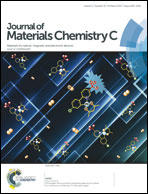High density array of multiferroic nanoislands in a large area†
Abstract
We report the innovative fabrication of a high density array of multiferroic BiFeO3 (BFO) nanoislands on a conductive substrate in a large area. The anodic aluminum oxide (AAO) template has widely been used to fabricate highly arranged nanostructures, because of easy control of pore size and perfect hexagonal pore packing. The existing AAO mask-assisted pulsed laser deposition (PLD) method is limited to fabricating a nanoisland array in a small area. To supplement the shortcoming of this method, a thick AAO membrane in a large area was electrochemically detached and floated on polystyrene (PS) film without crack. Then, a nanoporous polystyrene (PS) template was prepared by dry etching with the thick AAO membrane mask, followed by spin coating of the BFO precursor on the PS template. After removing the PS template at high temperature, we prepared a high density array of multiferroic BFO nanoislands in a large area epitaxially grown on an STO:Nb (100) substrate. A high density array of BFO nanoislands in a large area showed both ferroelectricity of individual nanoislands obtained by piezoresponse force microscopy (PFM) and macroscopic magnetism measured by a superconducting quantum interference device (SQUID) based magnetic property measurement system (MPMS). A high density array of BFO nanoislands could be employed as a next-generation memory device capable of electric writing and magnetic reading (or vice versa).


 Please wait while we load your content...
Please wait while we load your content...